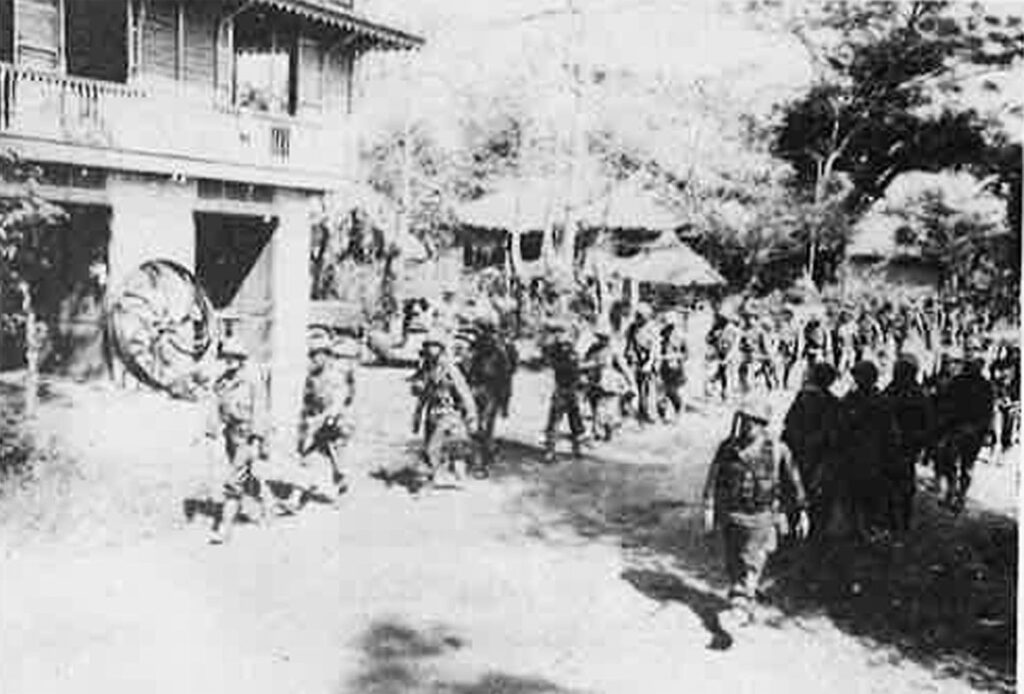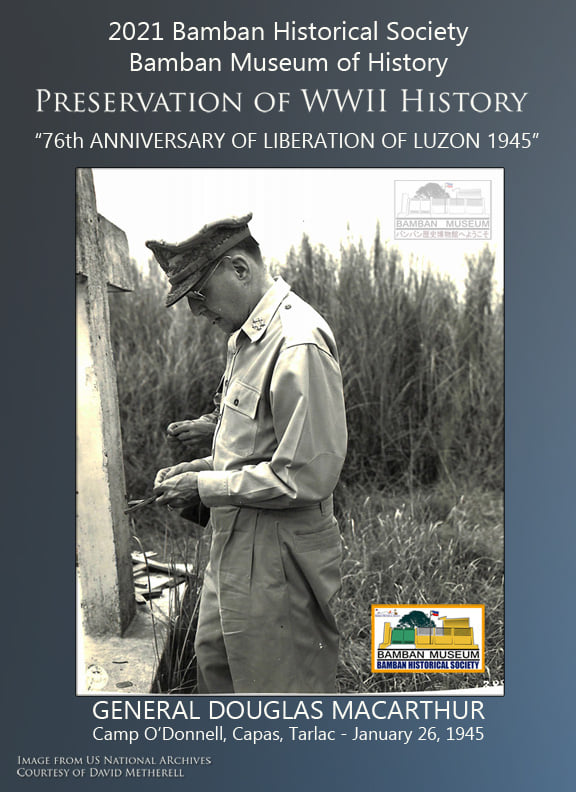
WWII 1945 IN TARLAC
The people of Capas, many of whom are descendants of WWII veterans, may have forgotten an important event in WWII History, the Liberation in January 19, 1945 and the arrival of the US Army 40th Division. After Tarlac, Tarlac was liberated by the American division under General Douglas MacArthur’s 6th Army with the aid of the local USAFFE guerrillas of the Tarlac Military Area (Luzon Guerrilla Army Forces -LGAF) under Captain Albert Hendrickson and his local commander, Major Cris Hipolito, the remaining forces of the Japanese Takayama Detachment and other units numbering 6,000 men retreated further south in to Bamban area. On the drive to the south along the main Highway 3 (present MacArthur Highway), the next target will be the neighboring town of Capas. With the departure of the main Japanese forces at the town poblacion on January 18, 1945, the gallant officers and men of the Capas Battalion, led by Captains Clark Kellog and Albert Stockton, took the heroic action for the town’s Liberation.

JAPANESE FORCES
Capas is well remembered in the history of WWII as the terminus of the Bataan Death March, at the O’Donnell Prisoner of War Camp, wherein the survivors of the Filipino-American defenders of Bataan, as surrendered numbering close to 60,000 men, were imprisoned. As early as June and the latter months, the Filipino POWs were released as part of gesture to entice good relations with Filipino leaders. The American POWs were transported to other camps, mostly at Cabanatuan. Camp O’Donnell had become a Japanese garrison, along with that at the Gabaldon Elementary Schools and the church convent at the downtown led by Lt. Akuchu, Lt. Isagami, and Capt. Fuji. Captain Yamaguchi was the district commander of the Japanese Military Police with field headquarters at Capas, Bamban and the nearby town of Concepcion during the Occupation. Lt. Tamura became the Japanese commanding officer of the town garrison. By 1944, the south-end of the town bordering Bamban became an important Japanese Army airfield called Tala Airfield (also Bamban Airfield). By January 9, 1945, with the landing of General MacArthur’s forces at Lingayen, the local USAFFE guerrillas of Capas were very active with the anticipation of the arrival of American division. With the retreat of the Takayama Detachment into Bamban from Tarlac, Japanese located at the south end of Capas emplaced Type 10 120-mm dual purpose naval guns. With the composition of the Clark Area composite division known as the Kembu Group, the O’Donnell mountain became part of the 13th Naval Combat Sector under the command of Captain Unosuke Nakamura.
FILIPINO UNITS
Some of the USAFFE defenders of Bataan that were imprisoned and later released at Camp O’Donnell were from Capas and Bamban town, and some of those who escaped during the march organized the local resistance starting in 1942. Capas Battalion (Company A with 86 and Company B with 193 officers and men) was organized and led by Major Albert Stockton in September 1942 as Squadron 11-D, later evolved into Company A, Bruce Guerrillas and eventually became Capas Battalion in 1944. At the west of Capas, the USAFFE outfit O’Donnell Regiment was led by Major Eliseo Mallari (26th Cavalry PS), whose unit begun organizing in September 1942 as Tarlac IV District organized by then Lt. Col. Claude A. Thorpe and Capt. Wilbur Lage after their escape from Mt. Pinatubo. The unit became under the overall command of Captain Bruce after the death of Lt. Col. Thorpe. There were also smaller USAFFE guerrilla units operating in the mountains of Capas by the Ayta warriors, the Biniayan Company (located on the mountains of Biniayan) and the Negrito Special Troops who were attached to O’Donnell Regiment. These USAFFE guerrilla units played an important role in keeping the semblance of Commonwealth Government during Occupation Period, conducting guerilla warfare and rescuing American downed pilots during the air war and later in the combat and clearing operations in the mountains in 1945.

LIBERATION BY THE CAPAS BATTALION
The Japanese Army begun withdrawal into mountain positions to the west and near the south of the town as part of the mobilization of the Kembu Group by the middle of January 1945. With the descending of the American forces, an American naval ace pilot rescued by the Capas Battalion was escorted by the troops of the Capas Battalion to be turned-over to the American line by Major Stockton on January 13. As the American 40th Division advanced to the south, Capas Battalion fought the remaining Japanese forces and liberated the town on January 18 and 19, 1945 with 3 USAFFE guerillas killed. As the Japanese retreated, they blew up the railroad and vehicular bridge over the Cutcut River. On the evening of January 20, 1945, a 200-men Japanese forces descended near the old cemetery, where a stiff engagement was fought by the Capas Battalion. The former Japanese garrisons at the Gabaldon schools were occupied by the Capas Battalion and Major Stockton established headquarters at the Municipal Building.

AMERICAN 40TH DIVISION ENTERS CAPAS, JANUARY 21-22, 1945
On January 21, 1945, elements of the 40th Division Cavalry Recon Troops entered the town but went further south to Bamban for advance reconnaissance missions. Major Donald Moore of the 1st Bn, 160th Infantry 40th Division, with his Company A and Company D, hurriedly went to the former O’Donnell POW Camp on the same day to check on the situation of the enclosure. On the following day, January 22, 1945, 7.34 a.m., American troops under the 40th Cavalry Recon Troops led by Lt. Pathory and 2nd Lt. Alsup met the Capas Battalion. Major Stockton raised the Philippine Flag at the headquarters and met the main body of the American forces under the 40th Division commanded by Major General Ralph Brush along with the 640th Tank Destroyer Battalion – Reconnaissance Company. Later, the other units of the 40th Division arrived at Capas, including the division artillery, and the 143rd Field Artillery.
THE DEFENSE OF CAPAS BRIDGES, JANUARY 23, 1945
As the main body of the 40th Division advances along the road to Bamban on January 23, 1945, the Japanese fired their Type 10 120-mm dual purpose gun on the American position at Capas. The 143rd Field Artillery made counter battery fire. A large body of Japanese infantry, probably from the Takayama Shitai unit, counter-attacked at the Company A, 115th Engineering Battalion working at the vehicular and railroad bridges of Cutcut, Capas, where men of the Capas Battalion, along with the 40th Division troops fought tenaciously. Six men were killed, ten wounded and 3 Filipino guerrillas died in the encounter while 12 Japanese were counted dead in the nearby sugarcane fields, as they retreated to the mountains. Officers and men of the Capas Battalion were attached to the 40th Division Quartermaster and with the 115th Engineering Battalion.
As the day ends on January 23, 1945, the main body of the Capas Battalion, as well as those of Major Eliseo Mallari’s O’Donnell Regiment were attached to the 40th Division for operations at O’Donnell area. The day marked also the entry of the 40th Division into Bamban, as the main front line between the American division and the Kembu Group. On January 26, 1945 (January 29 on the other source), General Douglas MacArthur visited the former POW enclosure Camp O’Donnell or Capas POW Camp, where he inspected the American cemetery with the concrete cross erected by the American prisoners, as well as the Filipino cemetery, with a monument designed by Capt. Elias L. Ruiz and constructed by the Filipino POW engineers. General MacArthur’s visit to Camp O’Donnell was captured by combat film, giving respect and honor to the vanquished soldiers of Bataan.

IN MEMORIAM
As a descendant of WWII veterans, I entreat that we shall remember history, particularly the Liberation of Capas, those who gave the ultimate sacrifice and the subsequent events for the gallant stand of the Filipino and American soldiers at the town, that their sacrifices shall not be forgotten.
Rhonie Dela Cruz
Bamban Historical Society
Bamban Museum of History
Citation:
(1) Capas Battalion, Southern Tarlac Military District (STMD), Luzon Guerrilla Forces (Box No. 485, File No. 286-3). Philippine Archives Collection, PVAO.
(2) Delk, James D. The Fighting Fortieth in War and Peace. California: ETC Publications, 1998.
(3) Dela Cruz, Rhonie C. Kembu Group Record of The Command, Units & Elements at Clark-Bamban Area 1945. Bamban Historical Society Collection, Bamban Museum, Bamban, Tarlac.
(4) Ongpauco, Fidel L. They Refused to Die: True Stories About WWII Heroes in the Philippines 1941-1945. Manila: Vera-Reyes, Inc., 1982.
(5) General MacArthur Inspecting Camp O’Donnell Prisoner of War Enclosure with date of production January 29, 1945. U.S. National Archives NARA.
Photos
(a) General Douglas MacArthur, at the former O’Donnell POW Enclosure, inspecting the cement cross, January 26, 1945.
US National Archives, NARA, Bamban Museum Collection.
(b) Troops from the 185th Infantry, 40th Division at Sto. Domingo, Capas, late January 1945.
40th Division in WWII.
(c) Local USAFFE guerrillas from Capas; Capas Battalion.
Bamban Historical Society Collection
(d) Burned building of the Gabaldon Elementary School in Capas, the former Japanese garrison.
US National Archives, NARA, Bamban Museum Collection.
(e) Capas Railroad Bridge, site of the battle on January 23, 1945; when elements of the Capas Bn and the 155th Engineering Bn, 40th Division engaged a strong force of the Japanese Takayama Shitai.
US National Archives, NARA, Bamban Museum Collection.

